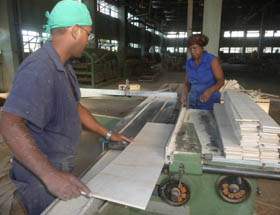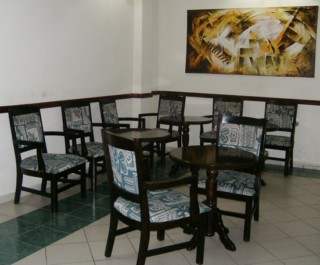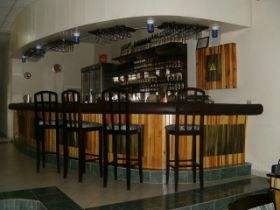Cuba Furniture Company Struggles On
Lazaro Gonzalez

HAVANA TIMES, July 1 — Given the incessant activity, its workshops could well be compared to an enormous termite colony. Here too, lumber disappears in an instant – but constructively. This company in Guantanamo (Cuba’s easterly most province) was about to go bankrupt a few years ago.
Today however, the workers are gradually seeing the rebirth of its glow, though they’re not exempt from the gloom of a few occasional shadows.
“In the middle of the last decade, “Muebles Imperio” (Furniture Empire) was a de-capitalized entity. All it had was debt, almost no markets and delays in meeting its production commitments. It was practically paralyzed,” said Enrique Delgado, the executive director. “We went into 2006 with net losses.”
That year the Ministry of the Light Industry paid off the debts to the company’s suppliers and the following year they received a loan from the Ministry of Economy and Planning. “Starting then, everything changed. We took charge of increasing our limited working capital. We resurrected ourselves from the ashes. Currently we have an entity that is strengthened, efficient and productive, has solid internal controls and is in the ‘Managerial Improvement Program’1,” its director pointed out.
Sanding off the rough edges
Founded in 1988, Furniture Empire has two production centers. One is basically responsible for the production of cradles and upholstered furniture, while the other one is tied to the provincial investment program and works under contracts in hard currency. One of its life savers was its joining the Local Development Program2, in 2007.
Although they are specialist in chairs, in its wide inventory of furniture selections what stands out is the furniture for hotels, restaurants, recreational complexes, offices and food service establishments as well as for business, educational and health care services. “We’ve contributed to distinguishing the identities of such facilities. We provide them with elegant, comfortable furniture, and in each case with a unique style – the majority designed by our specialists,” he added.
The high-backed seats and armchairs are their most well-known products. They also manufacture handles for shovels and rakes, among other work instruments.

Last year these veritable “beavers” consolidated the economic dike. They reached a historical record in commercial production and productivity. On the other hand, they couldn’t fulfill the specific plans for production for hard currency stores, tourism and exports. “We developed the plan based on production capacity. But over the last few years, the demand by the Dujo commercial enterprise has been very low. The plans don’t really connect with reality,” said Delgado.
Capacity Far Greater than Demand
Furniture Empire can furnish more than 700 rooms a year. Yet in 2010 it supplied furniture for only 35 bedrooms for the Punta Arena Hotel at the Varadero resort. Perhaps this was due to geographical fatalism since the firm is located almost 600 miles from Havana. For that reason the firm’s management demanded from the furniture contracting company more access to the contracts in hard currency.
So far the situation has improved in 2011. They have already signed contracts to furnish another 190 rooms at the Punta Area Hotel, the Jagua Hotel (in Cienfuegos) and at the Sierra Maestra Hotel in Santiago de Cuba. Nevertheless, this is still well below their capacity.
Given this situation, Delgado cannot understand why Cuba presently imports hotel furniture from Brazil and Vietnam. He wondered: “Is Guantanamo farther away than those countries? We demand that they look at us as a company that offers greater opportunities for import substitution.”
National suppliers and imports
The haphazard supply of wood (mostly imported) also clouds the tasks of the collective. The small amounts provided by the Local Forest Company “sometimes arrive with problems: it’s wet, green or cracked. That causes a lot of rejections,” noted the company’s founder, Jorge Planes, who is now head of the assembling team.
Alberto Salas, a carpenter in the machinery area, explained that the dependence on imports forces them to almost always work with their backs against the wall. They don’t have a stock of raw materials to guarantee the maximum pace of production. “Last year there was lots of downtime followed by overtime. Between November and December we worked double shifts and meet 60 percent of the plan for producing cradles. The warehouses were crammed.”

Furniture Empire is the largest producer of cradles in the country. It manufactures a third of the national total annually, almost all assigned to the Turquino Plan3. Production in 2010, for example, consumed about 350 cubic yards of pine, which was imported at more than $300 a cubic yard. “It would have been very different if we’d operated with nationally produced pine whose price isn’t more than $165 per cubic yard. But the Ministry of Agriculture can’t satisfy the demand of our industry. We continue paying for overseas wood, paying almost twice as much as the price of wood from our own forests, where we have tremendous reserves,” said Delgado.
Luis Manuel Viquillon, the general director of the Baracoa Forest Company4, confirmed the serious difficulties that are confronted in extracting thick wood (in planks) from the mountains and then sawing it. “The state of technology isn’t on our side. Our equipment is old. We’ve had problems with the tractor engines for almost a year. That’s why we can’t open the paths to the hardwood.”
According to the executive director of Furniture Empire, imports make the costs skyrocket: “As long as this industry isn’t protected by using nationally-grown wood, we’ll continue losing the domestic market.” A similar situation exists with export products because price increases reduce competitiveness. The last year, because we didn’t have any nationally grown mahogany, so they stopped making armchairs for export.
The shortage of plastic bubble wrap is another one of the headaches that result from sporadic supplies, almost all of it imported. “With the rest (glue, sandpaper, paint, screws, ironwork…) we don’t have problems, though nor do we have large inventories,” indicated Delgado. “We sometimes face complex situations. The last year we went half of that time without foam rubber for our upholstered furniture work, which was a blow to our sales in hard currency.”
The knots of relief
The main trump card in the “hard currency” market is quality. That premise has to be incorporated even in the last groove made by these Guantanamo cabinetmakers, who at the moment are implementing a quality control system based on norms of the International Organization of Standardization (ISO 9000).

Venus Restaurant manager Mayra Fuentes as well as Guantanamo Hotel manager Roilan Ribeaux — both of whom members of provincial government — praise the excellence of products crafted by Furniture Empire. “That company has years of experience and it seems to be intact,” said Ribeaux, pointing out a colorful living room set. They’re very functional, consistently of high quality, comfortable and they please the customers.
Like everything in life, carpentry and cabinetmaking are in danger of extinction in these parts if tomorrow’s seeds aren’t planted soon. “The industry is aging. It requires the renovation of the workforce,” warned 36-year veteran assembler Eugenio Martinez.
Delgado added: “Recently they began directing us to cut back on staff. In my opinion that’s an error. Our indexes of worker efficiency and productivity are high. Our greatest need is to implement a second work shift to increase production.”
In the inclement atmosphere of dark nimbuses, the benign termites of Furniture Empire are determined to expand and secure their reign. Directed at those who still don’t understand the idea of import substitution, each end product carries an engraved message. They pose the question: Is it sustainable to always throw away a sofa?
—–
1 A Cuban system of business administration that promotes relative managerial and financial autonomy, rigorous internal control, and high efficiency based on payment for individual and collective output. It was created by the Revolutionary Armed Forces in 1997 and then extended to other government entities with higher production indices.
2 Managed state financial program to improve the quality of life for the residents of Guantanamo Province, a level which for many years has remained very depressed in comparison to other provinces.
3 A government program that attends to the residents of Cuba’s mountainous rural areas.
4 This municipality — the second largest in Guantanamo Province — constitutes one of the primary forest reserves in Cuba and possesses the greatest amount of precious woods.






The existing structure, that hopefully will change with the new economical approach that will be instituted soon, is the only culprit of this and other business failures in Cuba.
These products, like most others, have never been promoted or sold to the population in Cuba. The province of Guantanamo alone, with its high purchasing power, its accumulated household needs, is capable of buying the entire production capacity of this factory, without anyone having to travel hundreds of miles to sell a few bedroom sets.
Give it a few more months with the new economical structures in place, and this plant will need to add a second or third shift to satisfy the population demands.
This remind me of the manager of a Cement factory in central Cuba, proudly telling a group of visitors to Cuba, about his upcoming business trip to Asia to promote his factory products, while thousands of Cubans were enduring every possible hardship, trying to acquire cement to repair or build their homes.